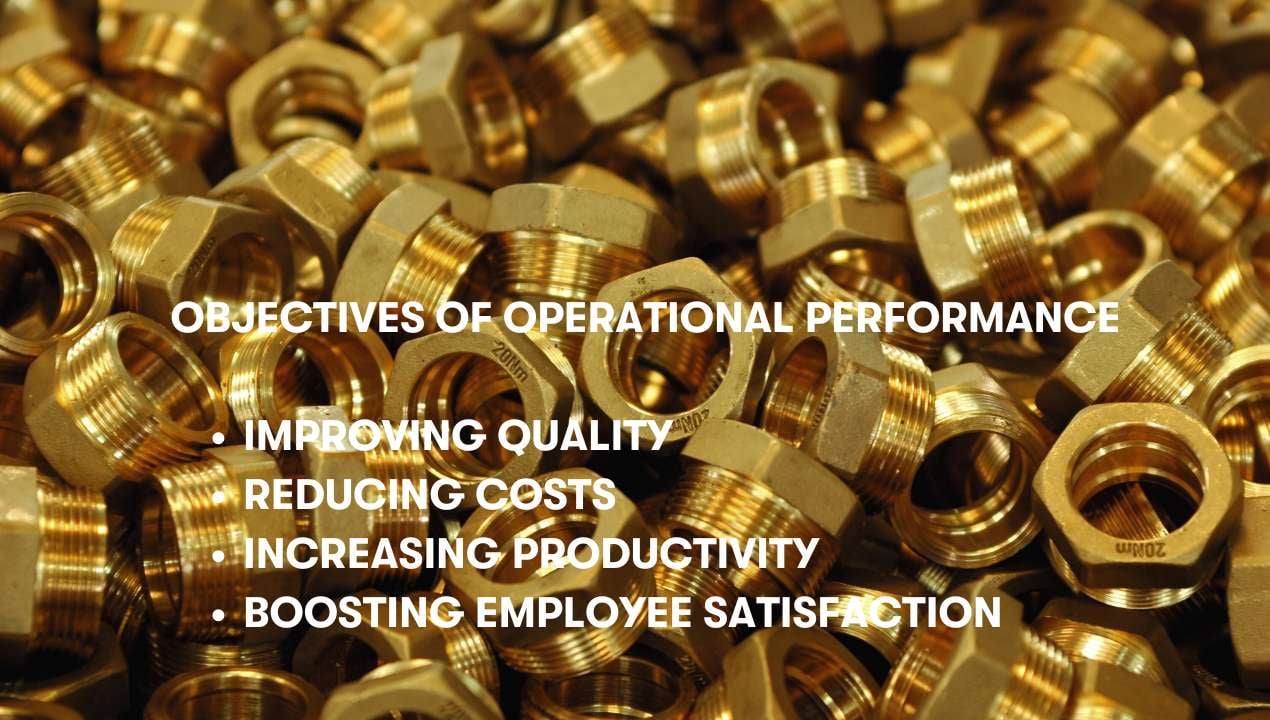Operational Performance Analysis or 10 Indicators to improve in manufacturing
| Written by Mark Buzinkay

No video selected
Select a video type in the sidebar.
In manufacturing, process efficiency and effectiveness count the most. Different conceptual models show that operational performance is a multidimensional construct that mainly depends on the production flow mechanisms. In addition, key performance factors vary in importance and influence and are temporally interrelated (1).
What is operational performance?
Operational performance measures how well a business performs its core activities. It's calculated using key performance indicators (KPIs), usually quantifiable measures of a process, process step, or program.
Typically, you follow a 4-step approach to analyse and optimise operational performance:
Step 1: Define your metrics
The first stage of evaluating operational performance is determining the metrics that matter most for the specific industry and individual objectives. Metrics are quantitative or qualitative criteria that mirror operations' efficiency, effectiveness, and quality. Depending on the industry, metrics such as productivity, throughput, cycle time, error rate, customer satisfaction, or revenue may be used. These metrics must be relevant, measurable, achievable, realistic, and timely (SMART) and align with strategic goals and customer expectations.
Step 2: Collect and analyse data
The next phase is to gather and examine data on your metrics using appropriate tools and methods. Operational systems, surveys, feedback, audits, or benchmarks can serve as various sources of data. Reliable and consistent data collection methods create accurate, complete and up-to-date data. Descriptive, predictive, or prescriptive analytics identify patterns, tendencies, gaps, and possibilities in operational performance.
Step 3: Compare and benchmark
The third step is comparing and benchmarking operational performance against objectives, standards, or contenders. Relevant and realistic comparison criteria, such as industry averages, best practices, or historical data, make the most sense. It would help if you also used internal, external, functional, or generic benchmarking to understand and identify areas for improvement.
Step 4: Implement and monitor
The final step is executing and observing the actions and changes to improve operational performance. Implementing and monitoring involves evaluating the initiatives, including using feedback loops, control charts, or performance reviews to follow and measure progress and impact.

What are the primary objectives of operational performance?
The primary operational performance objectives can differ depending on the institution and industry. However, some common objectives are:
- Improving quality: Maintaining and enhancing product or service quality is essential. Operational performance aims to reduce faults, errors, and rework while ensuring uniform and reliable outputs that meet or surpass customer anticipations.
- Reducing costs: Controlling costs is a vital objective for organisations. Operational performance aims to identify options for cost reduction, such as streamlining processes, eradicating inefficiencies, and optimising resource allocation.
- Increasing productivity and efficiency leads to improved profitability for the enterprise. It implicates maximising output while utilising the available resources efficiently. Organisations can gain higher production levels by enhancing productivity and delivering more value to customers (see also: Future Factory).
- Boosting employee satisfaction: It includes fostering a positive work environment, promoting employee engagement, and providing training and development opportunities to enhance skills and knowledge.
Key question: How do you calculate operational performance?
In order to measure efficiency and effectiveness, standard metrics are needed to capture operational performance. Some typical manufacturing KPIs are:
- Throughput: This measure shows how well machines are producing. When monitored in real-time, issues can be resolved before they become a bigger problem. Throughput is at its peak when machines are kept in good working order and manned by skilled operators. There are minimal touch points or steps that require the operator's attention to manufacture the product.
- Total cycle time (or lead time): This indicator measures how long it takes for a customer order to be concluded, from the start of production to shipment. It does not include idle time, just the actual time taken to manufacture the product. Total cycle time considers all factors in production, from raw materials to finished goods. It averages out the cycle times of all orders. By breaking down the lead time, you can more accurately pinpoint where the inefficiencies in the process occur (see also: AIDC).
- Equipment uptime: This indicator calculates the percentage of time that equipment is available and operational. It helps estimate the team's ability to keep critical assets running and indicates their effectiveness in preventing and resolving downtime issues. Production downtime is a period when the manufacturing process is on hold, and no products are produced.
- Overall equipment efficiency (OEE): OEE is a comprehensive metric that mixes availability, performance, and quality to gauge the overall effectiveness of equipment. It considers factors such as uptime, production speed, and product quality to provide insights into equipment performance and maintenance efficiency (learn more about industry 4.0 smart factory).
- Changeover time: This tracks the time it takes to complete everything for a production run, including activities such as unloading/loading, retooling, calibrating, and programming for the next job. Having this information helps manufacturers see areas for improvement. Maybe things can be better organised for setup. The faster the changeover time, the lower the cost of production.
- Mean time between failures (MTBF): MTBF calculates the average time between equipment failures. It helps gauge reliability and maintenance effectiveness by measuring how long equipment operates without experiencing failures.
- Mean time to repair (MTTR): MTTR measures the average time required to restore equipment to full functionality after a breakdown. A lower MTTR indicates efficient maintenance processes and quick response to failures.
- On-Time In-Full (OTIF): The On Time In Full is the key performance indicator that sums the number of orders delivered with the right quality and quantity on time to the customer.
- Inventory Turnover Ratio: Extra inventory is costly and ties up valuable resources. Space should be used for production, not for storing extra materials and components. The higher the inventory turnover rate, the leaner the supply chain.
- Production Schedule Attainment: This KPI echoes how well production is planned and how efficiently the production team meet their targets. In manufacturing, planning plays a critical role. The more complex manufacturing processes are, the more influential the capacity to execute the plan becomes. But it also becomes more tricky. Creating accurate production schedules to produce a certain amount of output according to the plan is very important if the manufacturer wants to meet the expectations of the customers and corporate objectives.
FAQ: Operational Performance Analysis
What exactly does operational performance analysis entail?
Operational performance analysis is a comprehensive evaluation method aimed at enhancing the efficiency and effectiveness of an organisation's operational processes. This analysis involves the systematic use of key performance indicators (KPIs) to assess the various dimensions of operational performance, such as productivity, efficiency, quality, and customer satisfaction. Through this analytical process, organisations identify areas of strength and opportunities for improvement, enabling targeted interventions to optimise operations and achieve strategic objectives.
What advantages can be gained from conducting an operational performance analysis?
The benefits of conducting an operational performance analysis are manifold and can significantly impact an organisation's success and sustainability. These advantages include:
- Enhanced Efficiency and Productivity: By pinpointing inefficiencies and optimising processes, organisations can increase their output and use resources more effectively.
- Cost Savings: Identifying areas where processes can be streamlined or resources better allocated often leads to significant cost reductions.
- Improved Quality: Analysis often reveals quality issues or bottlenecks affecting product or service quality, allowing for targeted improvements that enhance customer satisfaction.
- Informed Decision-Making: Armed with data-driven insights, management can make more strategic decisions regarding process improvements, resource allocation, and investment priorities.
- Competitive Edge: Organisations that regularly analyse and optimise their operational performance tend to be more agile, efficient, and customer-focused, positioning them more favourably in the marketplace.
How does technology impact operational performance analysis?
Technology plays a pivotal role in enhancing the effectiveness and efficiency of operational performance analysis. With advancements in data analytics, artificial intelligence (AI), and machine learning, organisations can now automate data collection, streamline analysis, and gain deeper, more actionable insights into their operations. These technologies enable real-time monitoring of performance indicators, predictive analytics for forecasting potential issues before they arise, and prescriptive analytics to suggest optimal solutions. Furthermore, digital tools and platforms facilitate the seamless integration of data from diverse sources, ensuring a holistic view of operational performance. This integration allows for more accurate benchmarking, trend analysis, and decision-making support. By leveraging technology, organisations can significantly improve their operational analysis processes, leading to faster identification of improvement opportunities, more strategic resource allocation, and, ultimately, a stronger competitive position in the market.
Takeaway
Understanding and leveraging key performance indicators (KPIs) alongside real-time data is crucial in today's competitive landscape. These elements serve as the compass that guides strategic decisions, enabling organisations to navigate through complexities with precision. Real-time data ensures that decisions are based on the current state of affairs, allowing for agile responses to emerging challenges. Emphasising KPIs and real-time data not only sharpens focus on critical success factors but also fosters a culture of continuous improvement and adaptability, positioning organisations for sustained growth and success.
Delve deeper into one of our core topics: Real time location systems
Sources:
(1) https://www.sciencedirect.com/science/article/abs/pii/S0278612521001291

Author
Mark Buzinkay, Head of Marketing
Mark Buzinkay holds a PhD in Virtual Anthropology, a Master in Business Administration (Telecommunications Mgmt), a Master of Science in Information Management and a Master of Arts in History, Sociology and Philosophy. Mark spent most of his professional career developing and creating business ideas - from a marketing, organisational and process point of view. He is fascinated by the digital transformation of industries, especially manufacturing and logistics. Mark writes mainly about Industry 4.0, maritime logistics, process and change management, innovations onshore and offshore, and the digital transformation in general.




